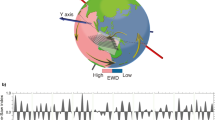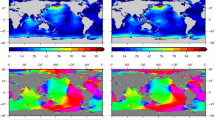Abstract
The rapid polar motion for periods below 20 days is revisited in light of the most recent and accurate geodetic and geophysical data. Although its amplitude is smaller than 2 mas, it is excited mostly by powerful atmospheric processes, as large as the seasonal ones. The residual amplitude, representing about 20% of the total excitation, stems from the oceans. Rapid polar motion has an irregular nature that is well explained by the combined influence of the atmosphere and the oceans. An overall spectrum reveals cycles principally at 20, 13.6 (fortnightly tidal period) and 10 days (corresponding to the normal atmospheric mode \({\Psi_3^1}\)), but this is only an averaged feature hiding its strong variability over seasonal time scales. This explains why it is so delicate to determine an empirical model of the tidal effect on polar motion. The variability in both amplitude and phase of the 13.6-day term is probably caused by a lunar barometric effect, modulated by some sub-seasonal thermal processes. The irregularities of the prominent cycles of the short-term polar motion are well explained by the atmospheric and oceanic excitations. The oceanic variability reinforces the atmospheric one, as they were triggered by the same agent, maybe seasonal and inter-annual thermal variations.
Similar content being viewed by others
References
Allan D (1987) Time and frequency (time-domain) characterisation, estimation, and prediction of precision clocks and oscillators. IEEE Trans Ultrason Ferroelectr Freq Control 34: 647–654
Arabelos D, Asteriadis G, Contadakis ME, Spatalas SD, Sachsamanoglou H (1997) Atmospheric tides in the area of Thessaloniki. J Geodyn 23(1): 65–75
Arabelos D, Asteriadis G, Bloutsos A, Contadakis ME, Spatalas SD (2004) Atmospheric tides disturbances as earthquake precursory phenomena. Nat Hazards Earth Syst Sci 4: 1–7
Barnes RTH, Hide R, White AA, Wilson CA (1983) Atmospheric angular momentum fluctuations, length-of-day changes and polar motion. Proc R Soc Lond A 387: 31–73
Bizouard C, Gambis D (2008) The combined solution C04 for Earth orientation parameters, recent improvements. In: Drewes H (ed) Springer Verlag Series on International Association of Geodesy Symposia 134. 330 p, ISBN 978-3-642-00859-7
Brzeziński A (1987) Statistical investigations on atmospheric angular momentum functions and on their effects on polar motion. Manuscr Geodetica 12: 268–811
Brzeziński A (1994) Polar motion excitation by variations of the effective angular momentum function, II: E xtended model. Manuscr Geodetica 19: 157–171
Brzeziński A, Bizouard C, Petrov S (2002) Influence of the atmosphere on Earth rotation: what new can be learnt from the recent atmospheric angular momentum estimates?. Surv Geophys 23: 33–69
Dickamn S (1993) Dynamic ocean-tide effects on Earth’s rotation. Geophys J Int 112: 448–470
Eubanks TM, Steppe JA, Dickey JO (1986) The atmospheric excitation of Earth orientation changes during MERIT. In: Proceedings of the international conference on Earth rotation and the terrestrial reference frame, 1985, Ohio State University, Columbus, pp 469–483
Eubanks TM, Steppe JA, Dickey JO, Rosen RD, Salstein DA (1988) Causes of rapid motions of the Earth’s pole. Nature 334: 115–119
Gambis D, Biancale R, Carlucci T, Lemoine JM, Marty JC, Bourda G, Charlot P, Loyer S, Lalanne L, Soudarin L (2009) Combination of Earth orientation parameters and terrestrial frame at the observation level. In: Drewes H (ed) Springer Verlag Series on International Association of Geodesy Symposia 134, 330 p, ISBN 978-3-642-00859-7
Gross R, Lindqwister U (1992) Atmospheric excitation of polar motion during the GIG’91 measurement campaign. Geophys Res Lett 19(9): 849–852
Gross R, Chao BF, Desai S (1998) Effect of long-period ocean tides on the Earth’s polar motion. Prog Oceanogr 40(1-4): 385–397
Gross R, (2009) An improved empirical model for the effect of the long period ocean-tides on polar motion. J Geod 83:635–644. doi:10.1007/s00190-008-0277-y
IERS Conventions (2003) IERS Technical Note No 32, Ed. DD McCarthy and G Petit, p 125
Kouba J (2005) Comparison of polar motion with oceanic and atmospheric angular momentum time series for 2-day to Chandler periods. J Geod 79(1-3):33–42. doi:10.1007/s00190-005-0440-7
Lambert S, Bizouard C, Dehant V (2006) Rapid variations in polar motion during the 2005–2006 winter season. Geophys Res Lett 33: L13303
Li G (2005) 27.3 day and 13.6 day atmospheric tide and lunar forcing on atmospheric circulation. Adv Atmos Sci 22(3): 359–374
Nastula J, Gambis D, Feissel M (1990) Correlated high frequency variations in polar motion and of the length of the day in early 1988. Ann Geophys 8: 565–570
Nastula J, Kosek W, Kolaczek B (1997) Analyses of zonal atmospheric excitation functions and their correlation with polar motion excitation functions. Ann Geophys 15(11): 1439–1446
Nastula J, Ponte R (1999) Further evidence for oceanic excitation of polar motion. Geophys J Int 139(1): 123–130
Petrov S (1998) Modeling excitation of Earth rotation: stochastic and nonlinear approaches. PhD thesis, Space Research Centre of the Polish Academy of Science, Warsaw, Poland
Ponte R, Ali A (2002) Rapid ocean signals in polar motion and length of day. Geophys Res Lett 29(15): 6
Salstein D, Rosen R (1989) Regional contributions to the atmospheric excitation of rapid polar motions. J Geophys Res 94(D7): 9971–9978
SBA (2009) WEB site of the IERS Special Bureau for the Atmosphere. http://ftp.aer.com/pub/anon_collaborations/sba/
SBO (2009) WEB site of the IERS Special Bureau for the Oceans. http://euler.jpl.nasa.gov/sbo/
Sidorenkov (2002) Fizika nestabil’nostey vrazheniya Zemli (Physics of the instabilities of the Earth’s rotation). Fizmatlit, Moscow, 384 p, ISBN 5-9221-0244-3 (in Russian)
Sidorenkov N (2003) Influence of the atmospheric tides on the Earth rotation. Celest Mech Dyn Astron 87(1–2): 27–38
Sidorenkov N (2008) Lunno-solnechnie prilivi i atmosferenie protsessi (Luni-solar tides and atmospheric processes, in Russian). Priroda 2: 23–31
Vondrak J (1969) A contribution to the problem of smoothing observational data. Bull Astron Inst Czech 20: 349
Vondrak J (1977) Problem of smoothing observational data II. Bull Astron Inst Czech 28: 84–89
WilsonCR(1985) Discrete polar motion equations.Geophys JRAstron Soc 80(2):551–554
Author information
Authors and Affiliations
Corresponding author
Rights and permissions
About this article
Cite this article
Bizouard, C., Seoane, L. Atmospheric and oceanic forcing of the rapid polar motion. J Geod 84, 19–30 (2010). https://doi.org/10.1007/s00190-009-0341-2
Received:
Accepted:
Published:
Issue Date:
DOI: https://doi.org/10.1007/s00190-009-0341-2




